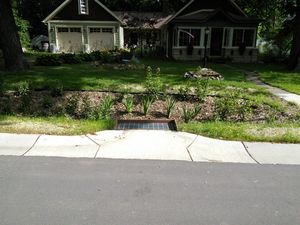
Difference between revisions of "Category:Level 3 - Best management practices/Pretreatment practices/Screening and straining devices"
(Created page with "Category:Level 2 - Best management practices/Pretreatment practices") |
m |
||
| Line 1: | Line 1: | ||
| + | [[file:RG pic2.jpg|thumb|300px|alt=pretreatment screen|<font size=3>Pretreatment screen for a residential raingarden. Photo courtesy of Katherine Sullivan.</font size>]] | ||
| + | |||
| + | '''NOTE:''' It is strongly recommended that pretreatment devices be certified through [https://ecology.wa.gov/Regulations-Permits/Guidance-technical-assistance/Stormwater-permittee-guidance-resources/Emerging-stormwater-treatment-technologies Washington State's TAPE] or [http://www.njcat.org/ New Jersey's NJCAT] programs, be modeled using [https://shsam.barr.com/ SHSAM], or follow guidance in this manual for <span title="Pretreatment vegetated filter strips are designed to provide sedimentation and screening (by vegetation) to treat stormwater runoff prior to entering a structural stormwater BMP. Pretreatment vegetated filter strips are especially effective at capturing excess sediment in stormwater runoff by settling solids. Pretreatment vegetated filter strips provide limited (due to size) volume reduction, peak flow reduction, infiltration, and biological treatment. Stormwater management processes not provided in pretreatment vegetated filter strips include filtration and sorption."> [https://stormwater.pca.state.mn.us/index.php?title=Overview_for_pretreatment_vegetated_filter_strips '''vegetated filter strips''']</span> and <span title="An artificial pool of water in front of a larger body of water. The larger body of water may be natural or man-made. Forebays have a number of functions. They may be used upstream of reservoirs to trap sediment and debris (sometimes called a sediment forebay) in order to keep the reservoir clean."> '''[https://stormwater.pca.state.mn.us/index.php?title=Pretreatment_-_Screening_and_straining_devices,_including_forebays forebays]'''</span>. | ||
| + | |||
| + | Screens provide a very specific and limited function of collecting large pollutants from stormwater runoff at defined sites along the stormwater flow network. Screens do not provide volume reduction, peak flow reduction, <span title="Sedimentation is the process by which solids are removed from the water column by settling. Sedimentation practices include dry ponds, wet ponds, wet vaults, and other devices."> [https://stormwater.pca.state.mn.us/index.php?title=Stormwater_sedimentation_Best_Management_Practices '''sedimentation''']</span>, infiltration, filtration, <span title="Absorption and adsorption considered as a single process"> '''sorption'''</span> and biological processes. | ||
| + | |||
[[Category:Level 2 - Best management practices/Pretreatment practices]] | [[Category:Level 2 - Best management practices/Pretreatment practices]] | ||
Revision as of 20:10, 7 February 2023
NOTE: It is strongly recommended that pretreatment devices be certified through Washington State's TAPE or New Jersey's NJCAT programs, be modeled using SHSAM, or follow guidance in this manual for vegetated filter strips and forebays.
Screens provide a very specific and limited function of collecting large pollutants from stormwater runoff at defined sites along the stormwater flow network. Screens do not provide volume reduction, peak flow reduction, sedimentation, infiltration, filtration, sorption and biological processes.
Pages in category "Level 3 - Best management practices/Pretreatment practices/Screening and straining devices"
The following 2 pages are in this category, out of 2 total.
